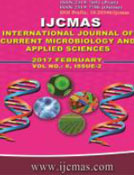


 National Academy of Agricultural Sciences (NAAS)
National Academy of Agricultural Sciences (NAAS)

|
PRINT ISSN : 2319-7692
Online ISSN : 2319-7706 Issues : 12 per year Publisher : Excellent Publishers Email : editorijcmas@gmail.com / submit@ijcmas.com Editor-in-chief: Dr.M.Prakash Index Copernicus ICV 2018: 95.39 NAAS RATING 2020: 5.38 |
The rice-wheat rotation is one of the world’s largest agricultural production systems occupying about 85% of the cultivated land in the Indo-Gangetic Plains (IGP) and nearly one-sixth of the total geographical area of the sub continent. The system accounts for about one-third of the area of both rice and wheat grown in South Asia. Rice-wheat rotations produce more than 45% of the region’s food and provide staple grains for nearly 42% of the total population of 1.3 billion of South Asia. Studies in past decade indicates that sustainability of rice-wheat system in IGP has been at risk mainly due to declining in groundwater levels, soil organic matter content and nutrient availability, increased soil salinization, incidence of pests and diseases. Practices commonly associated with sustainable management include accelerated adoption of resource conserving technologies (RCTs) and diversified crop rotations that enhance soil cover and fertility. In recent past a number of RCTs, like zero-tillage, bed planting, laser leveling, inter cropping of high value crops in the systems, has been introduced in the rice-wheat cropping system in IGP. The adoption of furrow irrigated raised bed (FIRB) planting technique at the farmer’s fields is at initial stage in the region. In this paper importance of bed planting system promotes crop diversification for improving livelihoods in IGP has been described.
 |
 |
 |
 |
 |